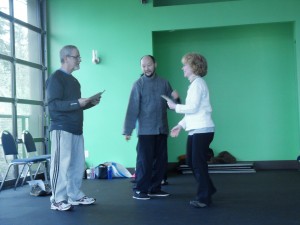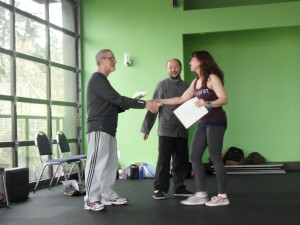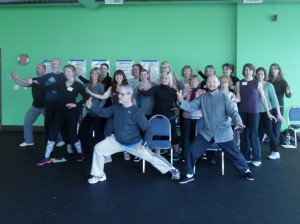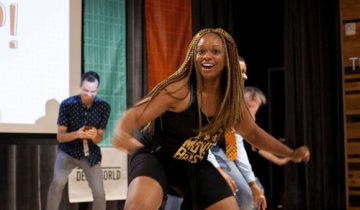One of the biggest fears of old people is falling, breaking something important like a hip, then being confined to a nursing home because they’re unable to care for themselves. According to Lisa Shields, falls prevention coordinator of Oregon Health Authority, many adults who are admitted to a hospital for a fall never go home.
The Centers for Disease Control works on four fronts of fall prevention: home modifications, adjusting medication, keeping vision prescriptions current, and exercise. According to Shields, exercise is by far the most fruitful intervention.
- James and Suman are in front. We’re all parting the wild horse’s mane.
So that’s why I spent last weekend with about 20 other folks in a two-day workshop called Tai Chi: Moving for Better Balance, hosted by West Coast Health & Fitness. Dr. Fuzhong Li of the Oregon Research Institute in Eugene developed this simplified 8-form version of traditional 24-form Yang style tai chi. This means that instead of 24 more complicated moves, this program teaches only 8 simpler moves. Which turned out to be plenty to try to master, or at least absorb, over the course of a weekend.
I took a few tai chi classes in the ‘90s, and went along to my mom’s class a time or two more recently. But I do not know tai chi. The Moving for Better Balance program aims to teach laypeople like me—fitness instructors who know little to nothing about tai chi—as well as tai chi instructors who want to focus more on teaching seniors.

We passed our test! Here Catherine Egan, my coworker at West Coast Fitness, receives her certificate.
We were fortunate to have two master instructors, Suman Barkhas of Eugene and James Lusk of Portland. Both embodied that kind of contained energy you can see in experienced tai chi practitioners, where they’re basically doing the same moves I learned but with obviously much deeper things going on behind the scenes. A few times James demonstrated the martial applications of what at first looked to me like random moves. I quickly saw that if James chose to move faster he could easily kick all our asses. Lucky for us, that’s not the point of tai chi.
The CDC has determined that at least 50 hours of tai chi is necessary to reduce your odds of falling. So far, the most effective tai chi interventions consist of at least two hours of weekly class instruction over six months. Studies are ongoing. We were invited to participate in data collection once we start our tai chi classes.

Here’s Sinead, my other West Coast Fitness coworker who took the training, proudly receiving her certificate.
By the end of the weekend, we had all been tested doing our forms in front of a panel of judges—Suman, James and Lisa—and passed. A few of my fellow students were already amazing at tai chi, having taught for years to a general population. Most were more like me, new to tai chi but committed to helping our senior students. When I watched the other groups perform the form, I was impressed by how graceful and convincing everybody looked after two days of practice.
I’m not sure yet where, when or how soon I’ll start teaching Tai Chi: Moving for Better Balance. But I’m looking forward to doing my part to reduce falls and keep my fellow humans as independent as possible.




